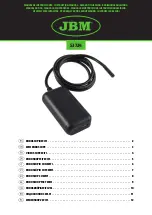
17
7.2
Pulsed output
The output is off by default. When the VTR6 is triggered it waits for a delay and
then pulses the output. This delay can be set from 0.01ms to 999ms.
Retrigger delay is the minimum allowed time from one trigger to the next. Any
triggers that happen too soon after the previous trigger are ignored. The
retrigger delay is set in multiples of 100us.
The delay, pulse width, retrigger delay and pulse intensity are all
configurable.
7.3
Switched output
Switched mode uses the trigger input to switch the output on or off using
the timing of the trigger signal. The output brightness can be varied from
0% to 100%.
The VTR6 applies the same duty cycle and pulse width limits as for pulse mode,
to prevent the light being damaged.
7.4
Internal trigger timer
An internal timer is available for continuous triggering in pulse mode. The
period of this timer is configurable.
Note:
The internal timer is mostly used when synchronising a camera using the
trigger output. Generally, it is not possible to run the light strobe from this
timer while free running the camera as they will not remain synchronised and
the images will have very variable intensity.
When this timer is turned on, the light strobe pulse and the trigger output are
both triggered by this timer. External triggers still work.
When troubleshooting during development, it is sometime useful to set this
timer to give regular light pulses.
7.5
Trigger input
The trigger input is used as follows:
Mode
Trigger input
Output
Switched
Trigger input = off
Output is off if P flag = 1
Output is on if P flag = 0
Trigger input = on
Output is on if P flag = 1
Output is off if P flag = 0
Pulsed
Trigger rising edge
Pulse is triggered if P flag = 1
Trigger falling edge
Pulse is triggered if P flag = 0
Note:
The P flag inverts the sense of the trigger input.
Summary of Contents for PULSESTAR VTR6
Page 1: ...PULSESTAR VTR6 Installation Guide Issue 005...
Page 2: ...For your notes...
Page 36: ...32...
















































